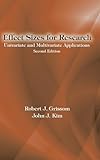Effect sizes for research: univariate and multivariate applications/ by Robert J. Grissom, John J. Kim.
Material type: TextPublication details: New York: Routledge, c2012.Edition: 2nd edDescription: xvii, 434 p.: ill.; 23 cmISBN:
TextPublication details: New York: Routledge, c2012.Edition: 2nd edDescription: xvii, 434 p.: ill.; 23 cmISBN: - 9780415877688
- 9780415877695
- 519.5/38 23
- PSY032000 | EDU027000 | SOC027000
| Item type | Current library | Call number | Status | Date due | Barcode | |
|---|---|---|---|---|---|---|
| Open Shelf | NIH Library NIH Library | QA279 .G75 2012 (Browse shelf(Opens below)) | Available | BK00070504 |
Includes bibliographical references (p. 391-419) and indexes.
"Noted for its comprehensive coverage, this greatly expanded new edition now covers the use of univariate and multivariate effect sizes. A variety of measures and estimators are reviewed along with their application, interpretation, and limitations. Noted for its practical approach, the book features numerous examples using real data for a variety of variables and designs, to help readers apply the material to their own data. Tips on the use of SPSS, SAS, R, And S-Plus are provided for the more tedious calculations. The book's broad disciplinary appeal results from its inclusion of a variety of examples from psychology, medicine, education, and other social sciences. Special attention is paid to confidence intervals, the statistical assumptions of the methods, and robust estimators of effect sizes. The extensive reference section is appreciated by all. With more than 40% new material, highlights of the new edition include: Three new multivariate chapters covering effect sizes for analysis of covariance, multiple regression/correlation, and multivariate analysis of variance. More learning tools in each chapter including introductions, summaries, "Tips and Pitfalls" and more conceptual and computational questions. More coverage of univariate effect sizes, confidence intervals, and effect sizes for repeated measures to reflect their increased use in research. More software references for calculating effect sizes and their confidence intervals including SPSS, SAS, R, and S-Plus. The data used in the book is now provided on the web along with suggested calculations for computational practice. Effect Sizes for Research, 2nd Edition covers standardized and unstandardized differences between means, correlational measures, strength of association, and parametric and nonparametric measures for between- and within-groups data. The book clearly demonstrates how the choice of an appropriate measure depends on such factors as whether variables are categorical, ordinal, or continuous; satisfying assumptions; sampling; and the source of variability in the population. Background information on multivariate statistics is provided for those who need it. Intended as a resource for professionals, researchers, and advanced students in a variety of fields, this book is also an excellent supplement for advanced statistics courses in psychology, education, the social sciences, business, and medicine. A prerequisite of introductory statistics through factorial analysis of variance and chi-square is recommended"--
There are no comments on this title.
